No one wants to meet a venomous snake unless you have a knack for taking risks. These creatures are among the most dangerous animals in the world.
According to statistics, an estimated average of 100,000 people die from snake bites every year. That’s a staggering reality.
There are many poisonous snakes around the globe, and some are more deadly than others.
The most venomous snakes in the world include the Black mamba, Russell’s viper, king cobra, and banded krait, among others.
Here’s a curated list of dangerous snakes and what you need to know about them.
Top 10 Most Venomous Snakes In The World
10. Black Mamba (Dendroaspis polylepis)

- Size: 6 ft 7 to 9.8 ft
- Habitat: Woodland, scrubs, semi-arid savanna
- Identifying Features: Long, slender, olive or yellowish brown color
- Behavior: Diurnal, arboreal, unpredictable
- Threats: Neurotoxin
The black mamba is a long snake, considered the longest in Africa and the second longest in the world. Only the king cobra surpasses it.
It is native to parts of Sub-saharan Africa, where the population is stable.
The black mamba inhabits woodlands, scrubs, and semi-arid savannas. Despite its name, black mambas are rarely black.
This snake is highly venomous, containing the fatal neurotoxin. The venom works fast, and within 10 minutes, the symptoms will manifest.
The latter include slurred speech, shortness of breath, and a general loss of bodily control.
Without the antidote, the black mamba’s venom is fatal. Its speed and length make it a formidable hunter, so beware.
9. Boomslang (Dispholidus typus)

- Size: 3.3 to 5.2 ft
- Habitat: Karoo shrubs, lowland forests, savannas
- Identifying Features: Large eyes, head shaped like an egg
- Behavior: Diurnal, arboreal, cannibalistic
- Threats: Hemotoxin
The boomslang is a member of the Colubridae family, and while not as large as the black mamba, it grows very long too.
It can be found only in Sub-saharan Africa, living in countries like Mozambique, Namibia, Botswana, and South Africa.
The boomslang differs from other members of its family that tend to be harmless.
This snake’s venom is a hemotoxin which can cause both internal and external bleeding.
This isn’t the only symptom to be aware of. The boomslang bite can cause mental disorders, headaches, and nausea.
8. Fer-de-lance (Bothrops asper)
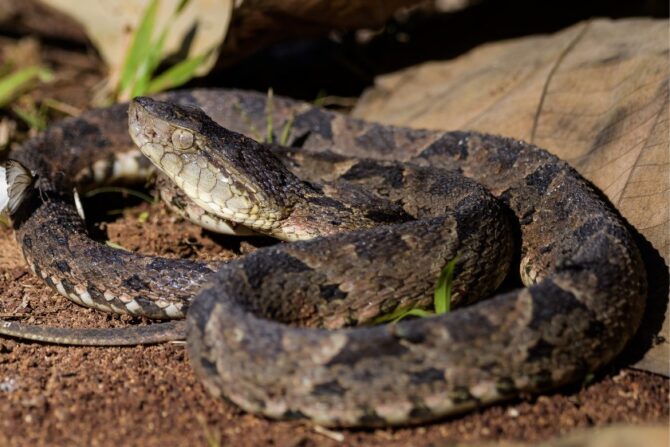
- Size: 3.9 to 5.9 ft
- Habitat: Forests
- Identifying Features: Broad head, light to dark brown or black color
- Behavior: Nocturnal, solitary
- Threats: Hemotoxin
The fer-de-lance is also called the terciopelo, a pit viper species that live in the Americas.
Countries it stays in include Mexico and Venezuela. It inhabits different types of forests, namely premontane, cloud, tropical rainforests, and evergreen forests.
This snake has a fearsome reputation, and for good reasons. It is both large and venomous, a combination that earned it the name “ultimate pit viper.”
The fer-de-lance is especially feared in its range. Though solitary, it stays close to humans and bites when on the defensive.
The fer-de-lance releases hemotoxin, like the boomslang.
7. Russell’s Viper (Dabola russelii)

- Size: 4 ft 1 inch
- Habitat: A variety except for dense forests
- Identifying Features: Yellow, tan color, flat head
- Behavior: Terrestrial, Nocturnal, Camouflage
- Threats: Neurotoxin, hemotoxin
The Russell’s viper is a native of India and is classified as one of the big four snakes in the country.
It was named after Patrick Russell, a man that wrote about the snake.
The Russell’s viper adapts well to different habitats but doesn’t seem to prefer dense forests.
The Russell’s viper is a master at camouflaging, so a potential victim may not notice the hidden snake until it strikes.
Being territorial, it often attacks when it feels someone has encroached on its territory.
The snake’s venom contains both neurotoxin and hemotoxin, making it very deadly.
Symptoms include hemorrhage, acute bleeding, shock, and renal failure.
6. Eastern Tiger Snake (Notechis scutatus)
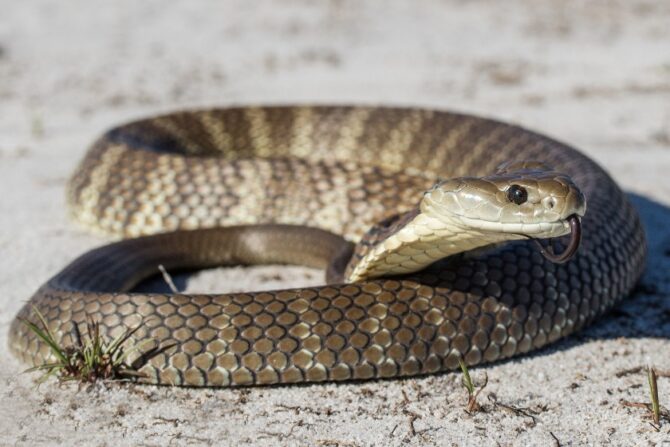
- Size: 3 ft 11 inches
- Habitat: Wetlands, creeks, dams
- Identifying Features: Dark patterns, a variety of colors
- Behavior: Aggressive, Diurnal
- Threats: Neurotoxin, coagulant, hemolysin, myotoxin
The eastern tiger snake is a native of southern Australia. It also lives on the coastal islands and Tasmania.
Its name comes from the dark bands around it, like that of an actual tiger.
The tiger snake inhabits wetlands, dams, and creeks. It is mainly terrestrial but knows how to swim.
Two traits make the eastern tiger snake dangerous: Its venom is very potent, and it is aggressive.
The venom is a combination of neurotoxin, coagulant, hemolysin, and mycotoxin.
With a mortality rate of around 40 to 60% (when untreated), the tiger snake is not to be toyed with.
Symptoms of its bite include tingling, numbness, sweating, and pain in some regions.
5. Saw-scaled Viper (Echis)
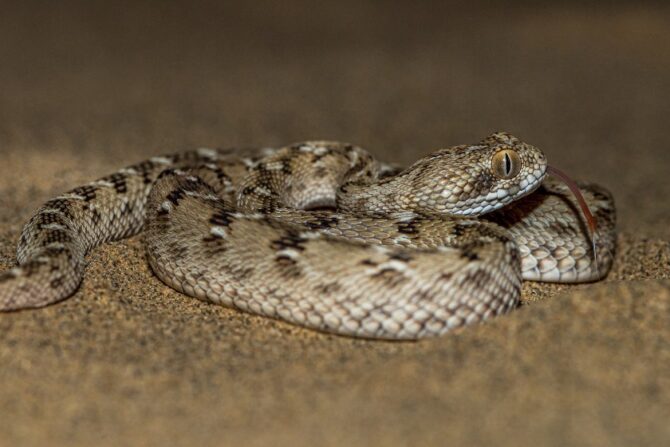
- Size: 12 to 35 inches
- Habitat: Arid, dry savanna
- Identifying Features:
- Behavior: Irritable, aggressive
- Threats: Neurotoxin, cardiotoxin, hemotoxin, and cytotoxin
The saw-scaled viper is the common name for the genus Echis. It can also be called the carpet viper.
This snake is native to Africa, the Middle East, India, Sri Lanka, and Pakistan. There are currently 12 species, all of which are venomous.
The venom is quite potent, containing four types of toxins: neurotoxin, cardiotoxin, hemotoxin, and cytotoxic.
All these contribute to making the saw-scaled viper a deadly animal responsible for causing the most snakebite and deaths.
Despite its size, it is very aggressive and can kill within hours.
4. Banded Krait (Bungarus fasciatus)

- Size: 8 ft 10 inches
- Habitat: Forest, agricultural land
- Identifying Features: Black and yellow crossbands, black eyes, small tail
- Behavior: Shy, nocturnal, lethargic
- Threats: Neurotoxin
The banded krait is the largest krait species and is found in Asia.
You’d specifically see it in southern China, the Indian subcontinent, and Southeast Asia.
In its range, it inhabits forests and agricultural lands, though not limited to those.
The banded krait’s venom can be deadly because of how potent it is. It contains a neurotoxin that will harm the victim.
Symptoms of this venom include vomiting, diarrhea, dizziness, pain, and even kidney failure.
Fortunately, the banded krait isn’t aggressive. It is shy and reclusive.
3. King Cobra (Ophiophagus hannah)

- Size: 10.4 to 13.1 ft
- Habitat: streams, dense, open forests, bamboo thickets
- Identifying Features: Olive green, black, and white bands
- Behavior: Avoidant, shy
- Threats: Neurotoxin, cytotoxin
The king cobra is arguably the most popular poisonous snake and the first species most people think of.
It is a native of Asia, the only place it can be found. Besides being popular, the king cobra is also the longest venomous snake in the world.
It inhabits streams in places like open forests and mangrove swamps.
The king cobra is highly venomous, comprising both neurotoxins and cytotoxins.
While it is shy and tends to avoid humans, it can be threatened and strike.
This snake bites multiple times and can kill a human within minutes. That being said, it is the national reptile of India.
2. Coastal Taipan (Oxyuranus scutellatus)

- Size: 6.6 ft
- Habitat: Forests, woodlands, grassy areas,
- Identifying Features:
- Behavior: Narrow head, olive or red-brown color, round eyes
- Threats: Neurotoxin
The coastal taipan is also called the common taipan, and it is one of the most feared snakes in the world.
A native of Australia and New Zealand, it dwells in the coastal regions.
The coastal taipan can be found in different habitats like forests and woodlands.
The coastal taipan is known for its speed and high venom, two traits that make it very dangerous.
It can pursue its target and bites multiple times when it gets its fangs on the victim.
Symptoms include headaches, convulsions, nausea, paralysis, and kidney damage.
1. Inland Taipan (Oxyuranus microlepidotus)

- Size: 5.9 to 8.2 ft
- Habitat: Black soil plains, arid region
- Identifying Features: Dark tan, brownish-light green
- Behavior: Diurnal (sometimes nocturnal), speed
- Threats: Neurotoxin, hemotoxin, myotoxin, nephrotoxin, hemorrhagic, hyaluronidase enzyme
The inland taipan is described as “extremely venomous,” earning it first place on many lists of dangerous snakes.
It is called the fierce snake for this reason. The inland taipan lives only in Australia, specifically in the central east.
You’d find it in the arid region and black soil plains. The inland taipan is usually active during the day, but in hot weather, it is nocturnal.
This snake’s venom contains a lot of toxins, including neurotoxin and hemorrhagic.
The venom is strong enough to kill 100 humans, and on a particular person, its effect works within minutes. This snake should be avoided.
Final Thoughts
We have only covered ten of the world’s most venomous snakes, and there’s way more than that.
However, these are enough to grasp how dangerous these creatures can be.
From the black mamba to the inland taipan, these deadliest snakes are sure to put you in a critical position if they should bite.
They are important to the ecosystem, however.
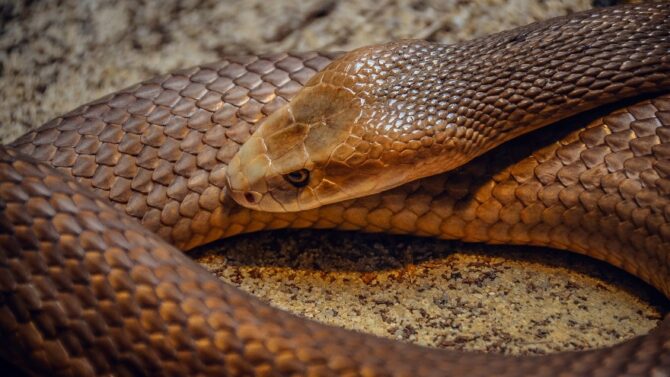

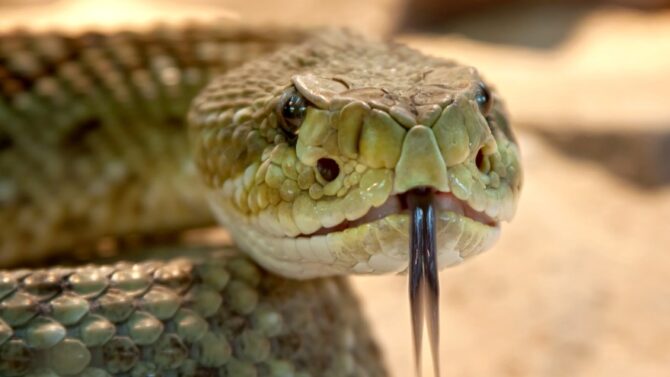
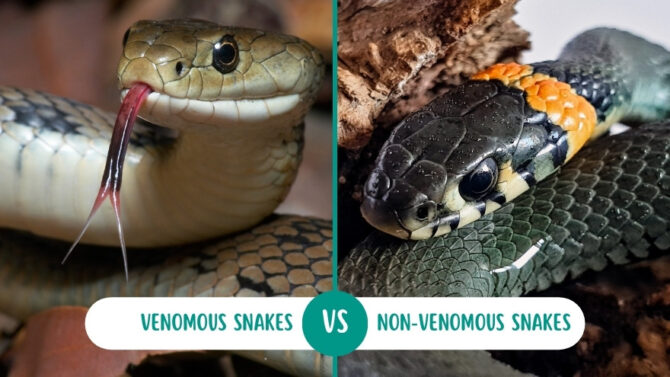


![How Often Do Corn Snakes Shed Their Skin [Answered]](https://animalvivid.com/wp-content/uploads/2022/11/How-Often-Do-Corn-Snakes-Shed-Their-Skin-Answered.jpg.webp)